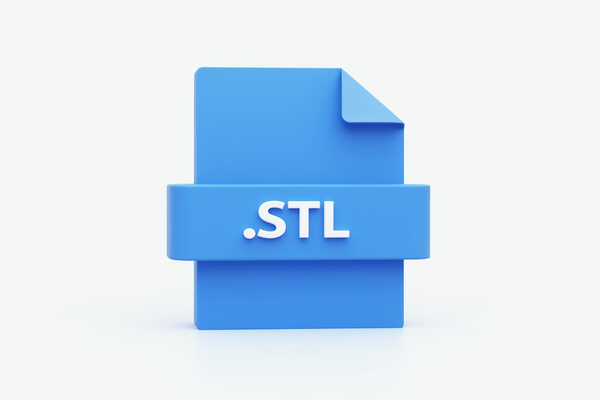The STL Format In CAD Explained
Ever wondered how your 3D designs come to life? The STL format is the unsung hero, bridging the gap between creative ideas and tangible results. Dive into what makes STL the go-to format for 3D printing, prototyping, and manufacturing. Learn what it is, how it works, key parameters, and its applications.

Have you ever tried 3D printing or working with CAD software, only to find yourself staring at the mysterious STL file format and wondering, “What exactly is this?” You’re not alone! If you’re designing 3D models for prototyping, manufacturing, or just tinkering with creative ideas, understanding the STL format is key to making your designs come to life.
In this blog post, we’ll dive into the STL format, breaking down its essentials, how it works, and how it fits into your workflow. Whether you’re a seasoned designer or just getting started, by the end of this article, you’ll have a clear understanding of STL and why it’s so crucial in the world of 3D design.
What is the STL Format?
STL stands for “Stereolithography,” and it’s one of the most common file formats used for 3D printing. Think of it as the “universal language” of 3D design—it’s simple, efficient, and compatible with most 3D printers and CAD software. When you save a model as an STL, you’re essentially telling the machine, “Here’s the geometry of the object you need to print,” without any extra details like textures or colors.
STL files represent a 3D object using a collection of tiny triangles. These triangles form a mesh that describes the surface of your model. Since STL files don’t carry information about the material or internal structure of the model, they’re often used for tasks like rapid prototyping, 3D printing, or CNC machining.
How Does It Work?
So, how does your 3D design get transformed into an STL file? The process starts in your native CAD software, where you create your 3D model. Once you’re happy with the design, you’ll “export” or “save as” an STL file.
When you do this, the CAD software slices your model’s surface into a mesh of triangular facets. These triangles are connected at their edges, forming a “shell” around the object. While your original model may have smooth, curved surfaces, the STL file approximates them using flat triangles. The more triangles you use, the more detailed and smoother your model will appear.
But here’s the kicker: the number of triangles will also affect the size of the file and its complexity. So, balancing detail with file size is important.
Parameters When Saving as STL
When you save your model as an STL, several parameters will affect the quality and size of the resulting file:
- Resolution: This determines how many triangles your model will have. Higher resolution means more triangles, more detail, and larger file size. A low resolution results in a jagged appearance. For fine detail, go with a higher resolution.
- Units: STL files don’t inherently carry any unit information. That means whether you work in inches, millimeters, or centimeters, your software needs to be set to the correct unit before exporting. Double-check your units to avoid scale issues.
- Orientation: The orientation of the model when saving as STL can impact the print quality. Make sure your model is oriented in a way that minimizes supports and maximizes strength during printing.
Recommendation: Start with medium resolution for a balance between file size and detail, and always check your unit settings to ensure accuracy.
Does Saving as STL Make the 3D Model Uneditable?
The short answer is no, saving a model as an STL does not make it uneditable. However, it’s important to understand that STL files don’t retain the full parametric or feature-based data that your native CAD files have. This means once you save it as an STL, you lose the ability to easily modify things like dimensions or shape in a parametric sense.
However, you can still edit STL files using mesh-editing tools like Meshmixer or Blender. These programs allow you to modify the triangular mesh, but it’s not as intuitive as editing your original CAD model. To preserve full editability, always keep an original copy of your design in the native CAD format.
Applications of STL: What is it Used For?
The STL format is widely used across various industries and applications, and here’s why:
- 3D Printing: STL is the go-to format for 3D printers. It translates your digital design into a physical object, layer by layer, in the printing process.
- Prototyping: Engineers and designers use STL files to quickly prototype products and parts. It allows for fast iterations, helping to bring ideas from concept to reality in no time.
- Manufacturing: CNC machining, laser cutting, and injection molding often use STL files to generate tool paths or create molds for production.
- Medical Applications: STL files are used in custom implants, prosthetics, and even surgical guides, where precision and personalization are crucial.
- Product Design: Designers and creators rely on STL files to create customized or complex parts that are difficult to manufacture with traditional methods.
Conclusion
Whether you’re a newbie or a seasoned designer, the STL format is something you’ll encounter frequently in the world of 3D design. From rapid prototyping to 3D printing and even medical applications, STL files are essential for turning digital ideas into tangible creations.
Remember, while STL files are incredibly useful, they do have limitations, especially when it comes to editing. Always keep an original copy of your design in a native CAD format for future tweaks and improvements.
Are you ready to start creating and sharing your own 3D models? Understanding STL is your first step! Happy designing!